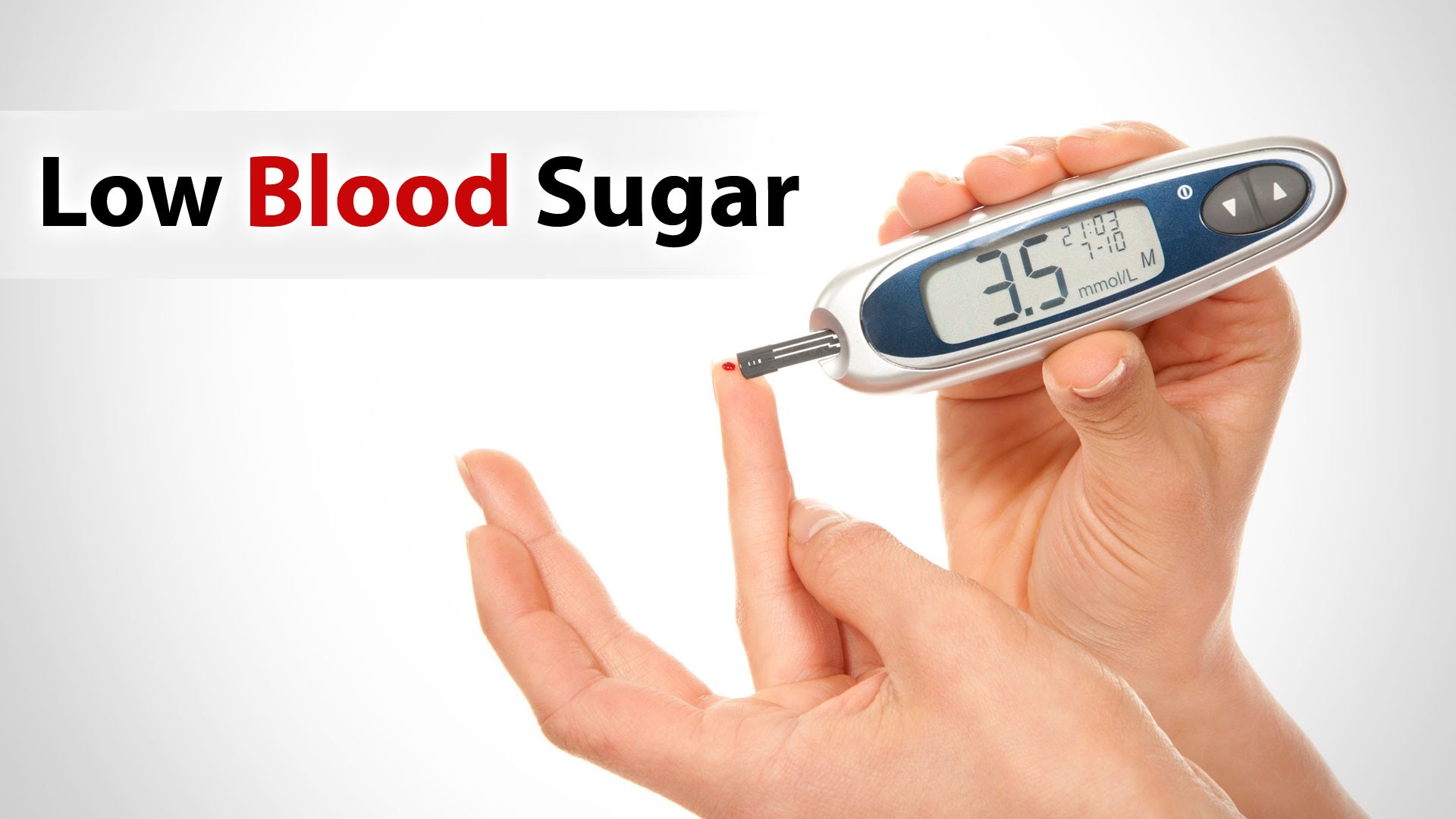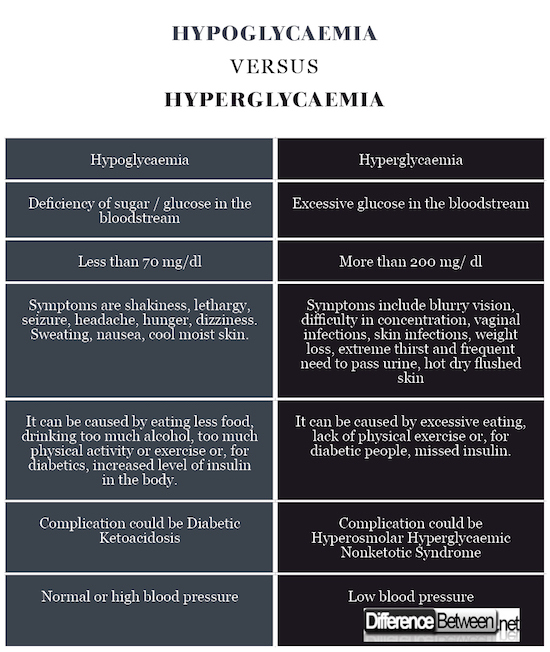Difference Between Hypoglycaemia and Hyperglycaemia
Hypoglycaemia
It is caused because of hypersecretion of insulin. It refers to deficiency of glucose in the blood.
Hyperglycaemia
It is caused because of hyposecretion of insulin. It refers to excess blood glucose levels in the blood.
Difference between Hypoglycaemia and Hyperglycaemia
-
Definition
Hypoglycaemia
Hypoglycaemia refers to an abnormally reduced level of sugar, or glucose, in the bloodstream.
Hyperglycaemia
Hyperglycaemia refers to an abnormally increased blood glucose (blood sugar) level. Hyperglycaemia is a hallmark indication of diabetic conditions (both type 1 diabetes and type 2 diabetes) and prediabetes.
-
Cause
Causes of Hypoglycaemia
The common causes of Hypoglycaemia are :
- Some medications that are meant to treat health issues other than diabetes can result in hypoglycaemia or even hide its symptoms.
- Tumours in the pancreas (insulinomas) or any autoimmune diseases increase insulin levels in the body and that can also cause Hypoglycaemia.
- Hypoglycaemia can also be caused intentionally by the inappropriate utilization of sulfonylurea medicines.
- Hypoglycaemia results when other diseases and health issues affect the body’s glucose metabolism. The diseases could be issue of pancreas and endocrine set up, disorders of liver, kidney and adrenal gland (such as Addison’s disease), In very unusual cases, nonpancreatic tumours cause hypoglycaemia.
- In rare cases, hypoglycaemia may result because of inherited enzymes.
- Alcohol leads to a drop-in blood glucose levels causing Hypoglycaemia.
- Other causes- Hypoglycaemia also may result during early pregnancy or with lengthened fasting or missed food, acute malnutrition, or due to long hours of strenuous physical activities.
Causes of Hyperglycaemia
Sometimes, hyperglycaemia is not the result of diabetic condition. Other conditions that can result in hyperglycaemia include:
- Pancreatitis (Swelling of the pancreas)
- Cancer in the pancreas
- Being inactive
- Hyperthyroidism (excited thyroid gland)
- Cushing’s syndrome (increased blood cortisol level)
- Suffering from any injury or having any surgery
- Unusual tumours that produce hormones like glucagonoma and pheochromocytoma.
- Having illness
- Any infection in the body
- Emotional stress
- Taking certain steroids like beta-blockers, prednisone, phenothiazines, estrogens, glucagon, oral contraceptives, and others, can increase blood glucose levels and cause Hyperglycaemia.
-
History
Hypoglycaemia
Elevated insulin levels
Hyperglycaemia
Omission or insufficient insulin.
-
Onset
Hypoglycaemia
The onset is usually fast with good health state previously.
Hyperglycaemia
The onset is usually slow with bad health state a few days before.
-
Pulse
Hypoglycaemia
Bounding and rapid pulse
Hyperglycaemia
Weak rapid pulse.
-
Blood glucose level
Hypoglycaemia
Hypoglycaemia, also called reduced blood sugar, takes place when the concentration of glucose in your blood drops less than the normal. For many individuals with diabetes, that means a level of 70 mg per decilitre (mg/dL) or low.
Hyperglycaemia
Hyperglycaemia does not show any symptoms until glucose levels are significantly increased and are above 200 mg per decilitre (mg/dL), or 11 millimoles per litre (mmol/L).
-
Signs and symptoms
Signs and symptoms of Hypoglycaemia
If blood sugar levels become excessively low, signs and symptoms may include:
- Tremor or trembling,
- Heart palpitations or an irregularity in heart rhythms
- Hunger
- Unexplained fatigue
- Pale skin
- Tingling lips and skin
- Shakiness
- Sudden mood changes
- Stress and anxiety
- Sweating
- Irritability
- Argumentative and combative
- Crying and shouting during sleep
- As hypoglycaemia gets worse, signs and symptoms may include:
- Confusion, abnormal personality changes, such as the incapability to finish routine activities.
- Disturbed eyesight, such as blurry vision
- Seizures and convulsions (jerky movements)
- An inability to focus and concentrate
- People with acute hypoglycaemia may look as if they’re inebriated. They may mumble their words and move gawkily.
Signs and symptoms of Hyperglycaemia
Recognizing initial symptoms of hyperglycaemia can help you address the condition before it worsens. Some of the symptoms include;
- Frequent peeing (Polyuria)
- excessive thirst (Polydipsia)
- Blurry vision
- Slow-healing cuts and sores
- Excessive intake of food (Polyphagia)
- Headache
- If hyperglycaemia remains unaddressed and untreated, it can result in toxic acids (ketones) to gather up in your blood and urine (ketoacidosis). Symptoms include;
- Fruity (Pear drop) smelling breath
- High levels of ketones in the urine
- Nausea and vomiting
- Excessive fever (over 101ºF)
- Shortness of breath
- Weight loss
- Dry mouth
- chronic constipation or diarrhoea
- Fatigue and tiredness
- Sleepiness
- Damage to blood vessels and kidneys
- Confusion
- Blood sugar more than 200 mg/dL
- Coma
- Pain in the abdomen
-
Commonest complication
Hypoglycaemia
Diabetic ketoacidosis (This condition occurs when your body secretes high levels of blood acids called ketones)
Hyperglycaemia
Hyperosmolar Hyperglycaemic Nonketotic Syndrome (HHS) is a complication of type II diabetes. It involves excessive high blood sugar level with absence of ketones
-
Diagnosis
Diagnosis of Hypoglycaemia
A diagnosis of hypoglycaemia is done not only on the basis of signs and symptoms. Rather, endocrinologists look at the Whipple’s Triad, named after Allen O.Whipple. These 3 factors help health practitioners diagnose hypoglycaemia.
Whipple’s Triad involves:
- reduced blood sugar level
- Signs of hypoglycaemia at the time of the low sugar level
- symptom relief with by treating the condition.
Reactive hypoglycaemia is diagnosed by a blood test. The test is done by fasting overnight, or between meals.
Diagnosis of Hyperglycaemia
Glycated haemoglobin (A1C) test
This blood test tells about your average blood glucose level for the past 2-3 months. It works by measuring the % of blood glucose associated with haemoglobin, the oxygen carrying protein in the RBC’s (red blood cells).
-
Treatment
Treatment for Hypoglycaemia
- Early symptoms can be treated by consuming 15 – 20 grams of glucose or simple carbohydrates.
- Recheck your blood glucose after 10- 15 minutes and if the condition continues, repeat to have sugar consumption
- If hypoglycaemia continues, repeat.
- Once blood sugar is at normal levels, eat some snack or a proper meal and keep an hour or two for your next meal.
Treatment for Hyperglycaemia
- Follow your diabetes meal plan: The food you eat must be in balance with the insulin performing in your body.
- Monitor your blood glucose level: Monitor your blood glucose levels to make sure that it remains within your target range.
- Take your medicines as prescribed by your general practitioner.
- Adjust your medication and treatment plan if you are changing your physical activity.
Emergency treatment for severe hyperglycaemia include:
- Fluid replacement.
- Electrolyte replacement.
- Insulin therapy.
Summary of Hypoglycaemia and Hyperglycaemia
The points of difference between Hypoglycaemia and Hyperglycaemia have been summarized below:
- Difference Between Global Warming and Greenhouse Effect - May 18, 2024
- Difference Between Vaccination and Immunization - March 3, 2024
- Difference Between Selective Mutism and Autism - February 25, 2024
Search DifferenceBetween.net :
Leave a Response
References :
[0]Asymptomatic, N. H. (2008). Glycemic Control and Hypoglycemia. DIABETES CARE, 31(10).
[1]Sommerfield, A. J., Deary, I. J., & Frier, B. M. (2004). Acute hyperglycemia alters mood state and impairs cognitive performance in people with type 2 diabetes. Diabetes care, 27(10), 2335-2340.
[2]Image credit: https://i.ytimg.com/vi/gCAQ6SOQFlI/maxresdefault.jpg
[3]Image credit: https://media.healthdirect.org.au/images/banners/w760h217/hyperglycaemia_h.jpg



